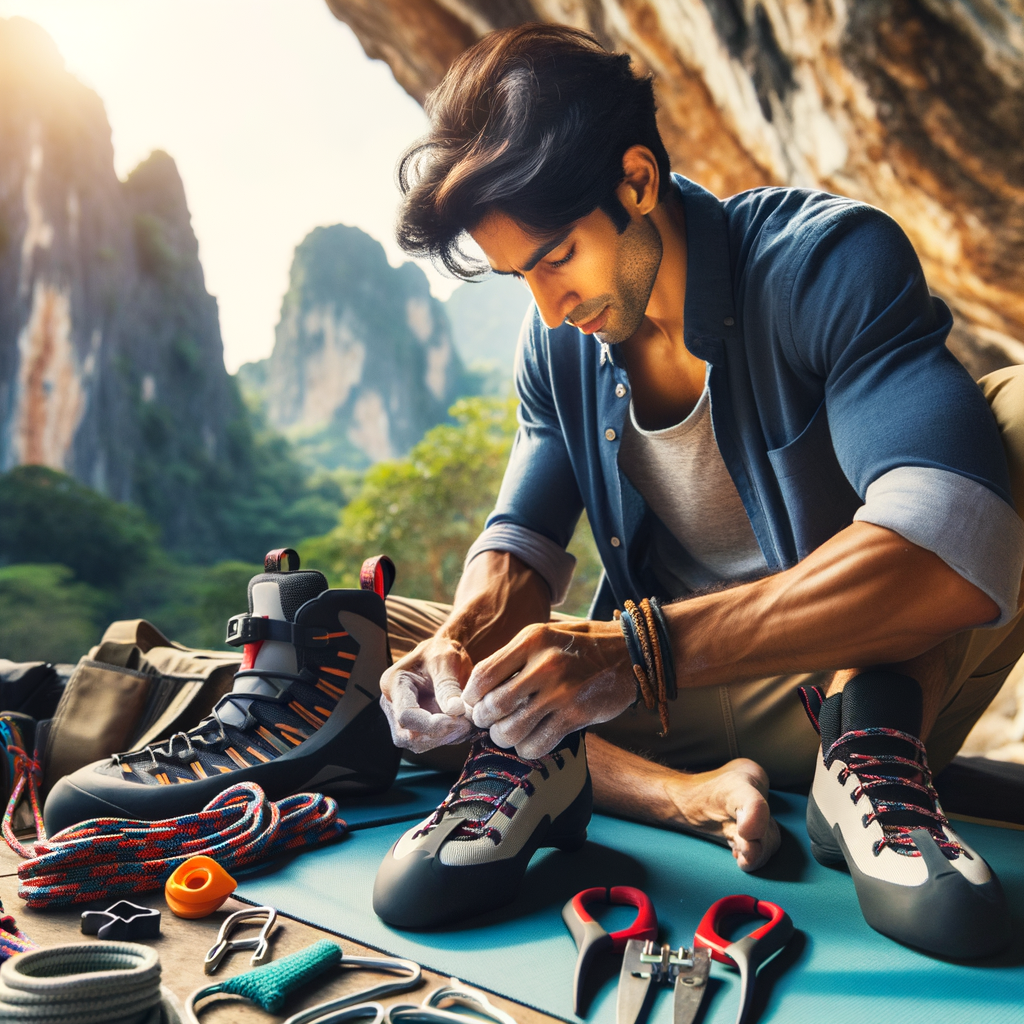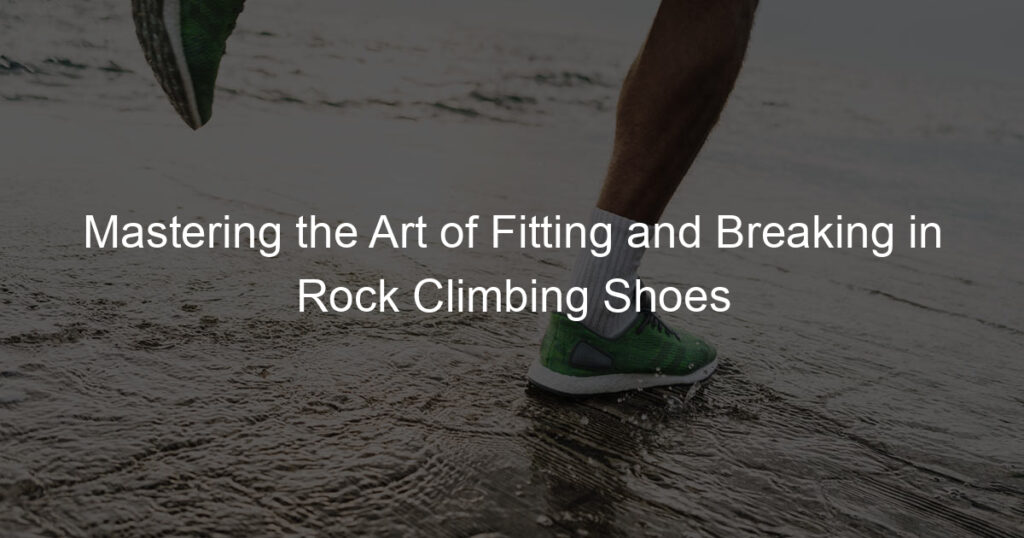
Introduction to Rock Climbing Shoes
Rock climbing is a thrilling sport that tests your physical strength and mental resilience. But did you know that your success in this sport can significantly depend on the type of shoes you wear? That’s right! Your rock climbing shoes can make or break your climbing experience. Let’s delve into the world of rock climbing shoes and understand their importance.
- Importance of Proper Footwear in Rock Climbing
- Different Types of Rock Climbing Shoes
- Neutral shoes: These are comfortable for all-day wear and are great for beginners. They have a flat profile and a medium to stiff midsole for support.
- Moderate shoes: These have a slightly downturned shape, which makes them good for technical climbing and providing grip on small holds.
- Aggressive shoes: These have a highly downturned shape and a tight fit. They’re perfect for overhanging climbs and difficult routes, but they can be uncomfortable for long periods.
When you’re hanging off a cliff, the last thing you want to worry about is slipping because of improper footwear. Rock climbing shoes are designed specifically to provide you with the grip and comfort needed to climb safely and efficiently. They are made with special rubber soles that stick to rocks better than any other type of shoe. This allows you to stand on tiny ledges, smear on slabs, and hook on overhangs. A study by the American Alpine Club shows that 75% of climbing injuries are due to falls, and having the right shoes can significantly reduce this risk.
Rock climbing shoes come in different types, each designed for a specific type of climbing. The three main types are:
Choosing the right type of shoe depends on your climbing style and the type of terrain you’ll be climbing. Remember, the right shoe can enhance your performance and make your climbing experience more enjoyable.
Properly Fitting Climbing Shoes
Having the right fit in your climbing shoes can make a significant difference in your climbing performance and comfort. Let’s delve into understanding climbing shoe sizes.
Understanding Climbing Shoe Sizes
When it comes to climbing shoes, size matters. However, the sizing of climbing shoes is different from that of regular shoes. Here’s what you need to know:
- How Climbing Shoe Sizes Differ from Regular Shoe Sizes
- Factors to Consider When Choosing Climbing Shoe Size
Climbing shoes are designed to fit more snugly than regular shoes. This is to ensure that your foot doesn’t move inside the shoe while you’re climbing. As a result, you may find that your climbing shoe size is smaller than your regular shoe size. For instance, if you wear a size 9 in regular shoes, you might need a size 8 or 8.5 in climbing shoes.
When choosing the size of your climbing shoes, there are several factors to consider. These include the type of climbing you’ll be doing, the shape of your foot, and your comfort level. For example, if you’re into bouldering or sport climbing, you might prefer a tighter fit for better performance. However, if you’re into traditional climbing or multi-pitch routes, a more comfortable fit might be more suitable.
Remember, the right fit for your climbing shoes is crucial. It can affect your climbing performance and the health of your feet. So, take your time to understand your needs and choose the right size.
Stay tuned for more insights on climbing shoe comfort vs performance and a comprehensive climbing shoe size guide in the upcoming sections.
Climbing Shoe Comfort vs Performance
When it comes to rock climbing shoes, the balance between comfort and performance is crucial. Let’s delve into this topic to understand how tight climbing shoes should be and how to strike the right balance between comfort and performance.
- How Tight Should Climbing Shoes Be?
- Balance Between Comfort and Performance
Many beginners often wonder how tight their climbing shoes should be. The answer is not as straightforward as it might seem. Climbing shoes should be snug but not painfully tight. They should feel like a second skin on your feet, allowing you to feel the rock beneath you. However, if your shoes are too tight, they can cause discomfort and even injuries. Remember, comfort is key to performance. If your feet are in pain, you won’t be able to climb effectively.
Finding the right balance between comfort and performance can be a bit tricky. While a snug fit is essential for precise footwork, too tight shoes can hinder your climbing performance. On the other hand, shoes that are too loose won’t provide the necessary grip and stability on the rock. Therefore, the best climbing shoes are those that provide a perfect blend of comfort and performance. They should be tight enough to ensure precise footwork but comfortable enough to wear for extended periods.
In conclusion, the comfort and performance of your climbing shoes are intertwined. A well-fitting pair of climbing shoes can enhance your climbing performance while ensuring your comfort. So, take your time to find the right pair that strikes the perfect balance between the two.
Climbing Shoe Size Guide
Getting the right size for your climbing shoes is crucial for both comfort and performance. This guide will help you understand how to measure your foot and what to look for when trying on climbing shoes.
- Measuring Your Foot for Climbing Shoes
- Place a piece of paper on the floor against a wall.
- Stand on the paper with your heel against the wall.
- Mark the longest part of your foot on the paper.
- Measure the distance from the wall to the mark you made. This is your foot length.
- Trying on Climbing Shoes: What to Look For
- Comfort: While climbing shoes should be tight, they shouldn’t cause pain. If they do, they’re probably too small.
- Heel fit: The heel of the shoe should fit snugly. If it slips off, the shoe is too big.
- Toes: Your toes should touch the end of the shoe, but they shouldn’t be painfully crunched.
Before you can find the perfect climbing shoe, you need to know your foot size. Here’s a simple way to measure your foot:
Remember, climbing shoes are designed to fit more snugly than regular shoes. So, don’t be surprised if your climbing shoe size is smaller than your regular shoe size.
When trying on climbing shoes, there are a few key things to look for to ensure a proper fit:
Remember, climbing shoes will stretch slightly as you break them in, so it’s okay if they feel a bit tight at first.
In conclusion, finding the right size for your climbing shoes involves measuring your foot accurately and knowing what to look for when trying them on. With the right fit, you’ll be able to climb more comfortably and efficiently.
Breaking in New Climbing Shoes
When you purchase a new pair of climbing shoes, it’s crucial to break them in properly. This process can help to ensure a comfortable fit and optimal performance on the rock face. Let’s explore the initial steps to take and common mistakes to avoid when preparing your new climbing shoes.
Preparing New Climbing Shoes
Before you start climbing in your new shoes, there are a few key steps you should take to prepare them.
- Initial Steps to Take with New Climbing Shoes
- Common Mistakes to Avoid
First, try on your new climbing shoes at home. Wear them for short periods of time to help your feet adjust to the new shape and structure. This can also help to stretch the shoes slightly, making them more comfortable for climbing. It’s important to note that climbing shoes should fit snugly, but not be so tight that they cause pain.
One common mistake many climbers make is trying to break in their shoes too quickly. This can lead to discomfort and potential injury. Avoid wearing your new shoes for long climbing sessions right away. Instead, gradually increase the amount of time you spend in them. It’s also important not to get your shoes wet as this can damage the material and affect their performance.
By taking the time to properly prepare your new climbing shoes, you can ensure they provide the support and grip you need to tackle any climb. Remember, patience is key when breaking in new climbing shoes. It may take a few climbing sessions before they feel just right, but the wait will be worth it for the improved comfort and performance.
Methods for Breaking in Climbing Shoes
When you first get your new climbing shoes, they might feel a bit tight. Don’t worry! This is normal. The shoes need to be broken in. Here are two methods you can use to break in your climbing shoes.
- Gradual Use
This is the most recommended method for breaking in climbing shoes. It involves gradually wearing your shoes during your climbing sessions. Start by wearing your new shoes for short periods of time. Then, as they start to feel more comfortable, you can wear them for longer periods.
Remember, the key here is patience. It might take a few weeks for your shoes to fully break in. But, this method ensures that your shoes will mold to your feet perfectly, providing you with the best fit and comfort.
- Speeding Up the Process: Do’s and Don’ts
While it’s tempting to speed up the breaking-in process, you need to be careful. Here are some do’s and don’ts to keep in mind:
| Do’s | Don’ts |
|---|---|
| Wear your shoes around the house to help them mold to your feet. | Don’t soak your shoes in water. This can damage the materials. |
| Use a shoe stretcher to gently expand the shoes. | Don’t put your shoes in the dryer. The heat can shrink the shoes and damage the rubber. |
Remember, the goal is to break in your shoes without damaging them. Always follow the manufacturer’s instructions and take good care of your climbing shoes.
Climbing Shoe Maintenance
Proper maintenance of your rock climbing shoes is essential for their longevity and your safety. One of the key aspects of this maintenance is regular cleaning.
Regular Cleaning of Rock Climbing Shoes
Keeping your rock climbing shoes clean can significantly extend their lifespan and improve your climbing performance. Let’s delve into why cleaning your climbing shoes is important and the best practices for doing so.
- Why Cleaning Your Climbing Shoes is Important
- Best Practices for Cleaning Climbing Shoes
- Use a soft brush: A soft brush can effectively remove dirt and grime without damaging the shoe material.
- Avoid harsh chemicals: Harsh detergents can damage the rubber soles of your shoes. Instead, use mild soap and warm water.
- Dry naturally: Avoid exposing your shoes to direct heat as it can cause the rubber to warp. Instead, let them dry naturally in a well-ventilated area.
- Regular cleaning: Don’t wait for your shoes to get extremely dirty before cleaning them. Regular, gentle cleaning is more effective and less damaging to your shoes.
Cleaning your climbing shoes is not just about aesthetics. It’s about preserving the functionality of your shoes. Dirt and grime can degrade the rubber soles of your shoes, reducing their grip on the rock. Additionally, sweat and moisture can lead to unpleasant odors and even fungal growth. Regular cleaning helps prevent these issues, ensuring your shoes remain in top condition for longer.
When it comes to cleaning your climbing shoes, there are a few best practices to follow:
By following these simple steps, you can keep your climbing shoes clean and functional, ensuring they serve you well on many climbing adventures to come.
Repairing and Resoling Climbing Shoes
Just like a car needs new tires, climbing shoes need new soles from time to time. This process is called resoling. It’s a cost-effective way to extend the life of your climbing shoes. Let’s delve into when and how to resole your climbing shoes.
- When to Consider Resoling Your Climbing Shoes
- The soles are worn thin or have holes in them.
- The rand (the rubber part that wraps around the toe) is worn through.
- You can see the midsole or the upper part of the shoe.
- How to Resole Climbing Shoes
- Remove the old sole: Use a knife to carefully cut off the old sole.
- Prepare the shoe: Clean the bottom of the shoe to remove any dirt or debris.
- Apply the new sole: Use a special shoe adhesive to stick the new sole onto the shoe. Make sure it’s aligned properly.
- Trim and shape the sole: Once the adhesive has dried, trim off any excess rubber and shape the sole to match the original design of the shoe.
Knowing when to resole your climbing shoes can be tricky. Here are a few signs that it might be time:
If you notice any of these signs, it’s probably time to consider resoling your climbing shoes. Remember, it’s better to resole your shoes sooner rather than later. If you wait too long, the damage may be too severe and you might need to buy new shoes instead.
Resoling climbing shoes is a task that requires precision and patience. Here’s a basic step-by-step guide:
While it’s possible to resole your climbing shoes at home, it’s often best to leave this task to the professionals. They have the right tools and expertise to ensure the job is done correctly.
In conclusion, resoling your climbing shoes can save you money and extend the life of your shoes. It’s important to keep an eye on the condition of your shoes and resole them when necessary. With proper care and maintenance, your climbing shoes can serve you well for many climbs to come.
Additional Rock Climbing Gear
After mastering the basics of rock climbing shoes, it’s time to explore the additional gear that can enhance your climbing experience. Let’s delve into the essential rock climbing equipment you should consider.
Essential Rock Climbing Equipment
Rock climbing is a thrilling sport, but it also requires proper gear to ensure safety and efficiency. Here’s an overview of the necessary equipment and some tips on choosing quality gear.
- Overview of Necessary Rock Climbing Gear
- How to Choose Quality Climbing Gear
Aside from climbing shoes, other essential gear includes a climbing helmet to protect your head from falling debris, a harness to secure you to the rope, carabiners to connect different parts of your gear, and belay devices to control a rope during belaying. Climbing ropes are also crucial, and they come in various types, each suited for a specific kind of climbing. Lastly, chalk and chalk bags help keep your hands dry for a better grip.
When choosing climbing gear, prioritize safety and comfort. Look for helmets that are lightweight yet sturdy, and harnesses that fit well and have gear loops. Carabiners should be easy to open with one hand, and belay devices should be compatible with your climbing style. As for ropes, consider the type of climbing you’ll be doing and choose a rope that suits it. Lastly, opt for chalk that provides good friction and a chalk bag that’s easy to access.
Remember, investing in quality gear is investing in your safety and performance. It’s always worth it to spend a little more for gear that will last longer and perform better. Happy climbing!
Caring for Your Rock Climbing Equipment
Keeping your rock climbing gear in top shape is essential for your safety and performance. Here are some key steps you can take to ensure your equipment lasts longer and performs better.
- Regular Maintenance Tips for Climbing Gear
- Inspect your gear: Always check your equipment for any signs of wear and tear before and after each climb. Look for frayed ropes, cracks in carabiners, or worn-out soles in climbing shoes.
- Clean your gear: Dirt and grime can degrade your equipment over time. Regularly clean your gear following the manufacturer’s instructions. Typically, warm water and mild soap work well for most gear.
- Repair or replace damaged gear: If you find any damage during your inspection, either repair it if possible or replace the equipment. Never risk climbing with damaged gear.
- Proper Storage of Rock Climbing Equipment
- Store in a cool, dry place: Heat and moisture can damage your gear. Avoid storing it in places like a hot car or damp basement.
- Keep away from chemicals: Certain chemicals can corrode or weaken your gear. Keep your equipment away from substances like bleach or gasoline.
- Organize your gear: Keep your gear organized to prevent it from getting tangled or damaged. Use storage solutions like gear racks or bags.
Regular maintenance of your climbing gear can significantly extend its lifespan and ensure it remains safe to use. Here are some tips:
How you store your climbing gear can also impact its longevity. Here are some storage tips:
In conclusion, caring for your rock climbing equipment is a crucial part of the sport. Regular maintenance and proper storage can help ensure your gear remains safe and effective for many climbs to come.
Conclusion: Mastering Your Climbing Shoe Routine
As we reach the end of our journey, let’s take a moment to reflect on the important lessons we’ve learned about climbing shoes. We’ve covered a lot of ground, from understanding the basics of rock climbing shoes to learning how to properly fit, break in, and maintain them. Now, it’s time to summarize these key takeaways and share some final tips for success.
- Recap of Key Takeaways
- Final Tips for Success
Firstly, we learned that the right climbing shoe can make a significant difference in your climbing performance. The fit of your shoe is crucial, and it’s important to remember that a snug fit is more beneficial than a loose one. Breaking in your shoes is a process that requires patience and care, but it’s well worth the effort. Lastly, proper maintenance of your shoes will extend their lifespan and ensure they remain effective on the rock.
As you continue your climbing journey, remember these final tips. Always try on climbing shoes before purchasing to ensure the right fit. Be patient when breaking in new shoes and wear them around the house to speed up the process. Regularly check your shoes for wear and tear and clean them properly to maintain their grip. And finally, don’t forget that climbing shoes are just one part of your climbing gear. A good harness, helmet, and rope are also essential for a safe and successful climb.
In conclusion, mastering your climbing shoe routine is a vital part of your climbing journey. By understanding your shoes and taking care of them, you can enhance your performance and enjoy a safer, more successful climb. Remember, every great climber started where you are now. Keep learning, keep climbing, and you’ll reach new heights in no time.









